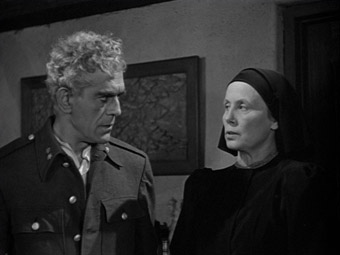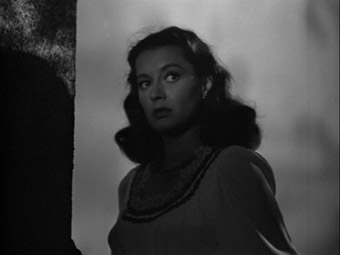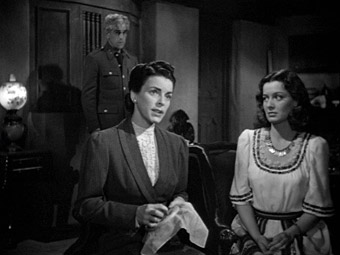| |
"His philosophy, in addition to scaring the wits out of people, was that he had a responsibility to the millions who saw our pictures. He aimed at more than mere exploitable crook shows, and wanted their impact to result from legitimate psychological conflicts. Lewton's pictures were cheaply made, but not cheap." |
| |
Director Robert Wise on Val Lewton |
Val Lewton may well be the only producer who has achieved auteur status. His name is forever linked with a style of subtle and suggestive but supremely effective and influential cinematic horror, exemplified by the string of films that were made while he was head of RKO's horror unit, starting in 1942 with Cat People and ending four years later with Bedlam. To this day they are regarded as Val Lewton films, despite being directed by respected luminaries Jacques Tournier, Mark Robson and Robert Wise. Lewton's stamp is on every one of them, and despite his collaboration with a number of writers, directors, cinematographers and editors, they are clearly the product of a single and unified creative vision.

The penultimate film in the Lewton cycle was Isle of the Dead, which was inspired by a painting by Arnold Böcklin (which sits behind the main titles and I'm sure is a favourite of director Tim Burton), written by Lewton regular Ardel Wray and directed by Mark Robson, a former editor who directed five films for Lewton, of which this was the fourth. Set during the 1912-1913 First Balkan War, it stars genre icon Boris Karloff as Nikolas Pherides, an army General renowned for his unforgiving strictness, which he demonstrates at the start by handing one of his officers a pistol with which to shoot himself after he failed to live up to the General's high-set standards.
Observing all of this is Oliver Davis (Marc Cramer), a young correspondent for the Boston Star, who may think Pherides' methods are a little extreme but is clearly not going to lose any sleep over it. He even tags along when Pherides takes a trip to a supposedly uninhabited cemetry island to visit his wife's grave, but on arriving at the tomb they discover that the coffin has been smashed and the body removed. Drawn by the sound of angelic singing, the two make their way to a house owned by retired archaeologist Mr. Albrecht (Jason Robards Snr.), who bought the property from superstitious local Madame Kyra (Helene Thimig), who has stayed on as his housekeeper. Albrecht reveals that fifteen years earlier it was he who inspired the local peasants to rob the graves in search of valuable artifacts, an act for which he apologises and was a key factor of his decision to abandon his profession.
Taking refuge from the war in the Albrecht abode are British diplomat St. Aubyn (Alan Napier), his frail wife Mary (Katherine Emery), Mary's young companion Thea (Ellen Drew), and homesick gor-blimey tinsmith Andrew Robbins (Skelton Knaggs), who less than a minute after being introduced is stumbling on the stairs looking thoroughly unwell. Pherides and Oliver are persuaded to spend the night, but when they rise the next morning, Robbins is dead. Pherides calls in army doctor Drossos (Ernst Deutsch), who determines that he died of septicemic plague and quarantines the island. As the condition begins to spread, Kyra and Pherides become obsessed with the notion that the deaths are actually the work of a vorvolakas, a vampire-like creature capable of transforming its victims into the undead.

If you like your horror loud and machine-gunned with action then you've come to the wrong place. Val Lewton films are driven as much by atmosphere as plot and there is plenty of both here. It's a talkative piece, but the sense of isolation and the feeling that the island is reclaiming its dead underpins every scene, while the studio-created exteriors and the singing that lures Pherides and Oliver to the Albrecht house are unsettling in that way that American horror films of the period really made their own. The plot unfolds in a nicely Old Dark House fashion, rolling a dice on who will become infected next and remaining teasingly ambiguous over the true cause of the deaths, as Pherides loses faith in medical science and joins forces with Kyra in targeting Thea as the likely cause. And despite her developing romance with pretty-boy Oliver, there are times when you wonder if he might be right.
It's in the final third that the film really delivers on the promise of its build-up, as Mary's catalepsy and terror of being buried alive collide with Pherides' conviction that she has been infected by Thea, providing a couple of spectacularly effective sound-driven jolts and the single biggest fright I've had from a movie all year. It's the handling of these scenes that prompted Martin Scorsese to select Isle of the Dead as one of the eleven scariest horror films he's ever seen. It's a well deserved accolade for a film that effortlessly demonstrates that an unsettling atmosphere, a disturbing sound or a sudden movement in the shadows can be more genuinely chilling than just about anything that the modern wonders of CG has so far been able to throw at us.
An NTSC to PAL transfer whose quality varies somewhat, though at its best displays good level of detail, a reasonable contrast range and strong black levels that only soften in the darker scenes. The image is largely stable and free of jitter, and while a fair amount of dust and the odd very visible scratch remain, the picture has clearly been cleaned up for its original NTSC incarnation and has survived the conversion rather well. Of course, a genuine PAL transfer would still have been preferable.

The Dolby mono 2.0 soundtrack has the expected restrictions in dynamic range and a trace of background crackle, but is otherwise clear and free of damage.
Nothing. A shame given Lewton's popularity and influence on later filmmakers.
This is old school horror as only Val Lewton and his team could deliver, a film whose atmosphere, pace and economy of storytelling build to a genuinely chilling final act that is peppered text-book examples of how to give your audience a good scare. That it all wraps up a little too neatly is par for the studio course of the time, even in horror.
Odeon's disc is a bare bones affair, but the transfer is rather good and it's available at a budget price. If you want to go to town on the cinema of Val Lewton you might consider Warner's region 1 Val Lewton Collection, which includes Isle of the Dead and eight other films, plus a number of extras including commentary tracks.
|